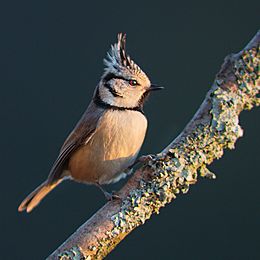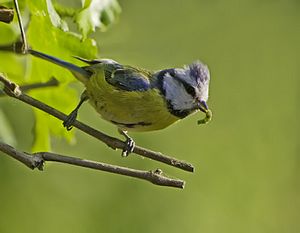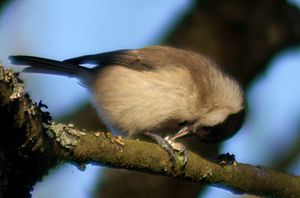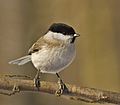Tit (bird) facts for kids
Quick facts for kids Tits and chickadees |
|
|---|---|
 |
|
| Crested Tit | |
| Scientific classification | |
| Kingdom: | |
| Phylum: | |
| Class: | |
| Order: | |
| Suborder: | |
| Family: |
Paridae
Vigors, 1825
|
| Genera | |
|
5-10, see text. |
|
 |
|
| Global range (In green) | |
| Synonyms | |
|
see text |
|
The Paridae is a family of small birds. They are often called tits in many parts of the world. In North America, people call them 'chickadees' or 'titmice'. These birds are songbirds. They live naturally in the northern parts of the world and in Africa. Many of these birds were once grouped together. They were all in a genus called Parus, but this group has now been divided.
These birds are usually small and strong. They live in woodland areas. They have short, strong bills. Some even have cool crests on their heads. Their size can range from 10 to 22 centimeters long. Tits are very good at adapting to different places. They eat a mix of foods. This includes both seeds and insects.
Many types of tits live near people. They often visit bird feeders to eat nuts or seeds. They can also learn to eat other foods. For example, in Britain, Great Tits and Blue Tits learned a clever trick. They would break through the foil caps on milk bottles. This let them get to the cream on top. But now, milk packaging has changed. So, they can no longer enjoy this special treat.
Tits are birds that build their nests in holes. They usually use holes in trees. However, some types build their nests on the ground. They lay eggs that are speckled white. The number of eggs can be from three to nineteen. This depends on the specific type of tit.
Contents
Amazing Tit Behavior
Tits are very active and noisy birds. They are also quite social. During the breeding season, they become territorial. This means they protect their nesting area. Tits are very good at adapting to new situations. They are also among the smartest birds. Only crows, jays, and parrots are thought to be more intelligent.
How Tits Communicate
Tits make many different kinds of calls and songs. They are some of the loudest birds. They call almost all the time. They only go silent for important reasons. For example, they might be hiding from a predator. Or they might be sneaking into a rival's area.
They make quiet calls while eating. This helps them stay in touch with their group. Other calls are used to warn about danger. The most famous is the "Chic-a-dee-dee" call. This call comes from North American species in the Poecile group. This call also brings other birds together. They will then mob and bother the predator. Scientists have shown that the more "dee" sounds in the call, the more dangerous the predator is.
What Tits Eat and How They Find Food

Tits are mostly insectivorous. This means they eat insects. They eat many small insects and other tiny creatures. They especially like small leaf-eating caterpillars. They also eat seeds and nuts, especially in winter. A common way they find food is by hanging. They will hang upside down to check branches, twigs, and leaves from every angle.
In areas where several types of tits live, they find food in different parts of a tree. Larger tits look for food on the ground. Medium-sized tits search on bigger branches. The smallest tits look on the ends of branches. If they find larger food or seeds, tits will 'hold-hammer' them. They hold the food with one foot. Then they hit it with their bill until it opens. They can open hazelnuts in about 20 minutes this way. Some types of tits also cache food. They store food supplies during the winter. These hidden stashes are usually seeds, but can also be insects.
Images for kids
-
The tufted titmouse lives only in North America.
-
The marsh tit was once in the Parus group. It is now in the Poecile group.
See also
 In Spanish: Páridos para niños
In Spanish: Páridos para niños






